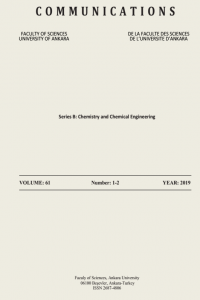SINGLE AND BINARY BIOSORPTION OF HEAVY METAL IONS AND A REACTIVE DYE BY ASPERGILLUS VERSICOLOR
Biyosorpsiyon atıksu arıtımında kullanılan, gelecek vaat eden bir metottur. Çalışmada, ölü Aspergillus versicolor fungusu ile sucul ortamdan Cr VI , Cu II , Ni II ve Remazol Blue RB boyasının tekli ve ikili giderimleri araştırılmıştır. Ağır metal iyonları için başlangıç konsantrasyonları 50- 150 mg L-1, RB için ise 25-700 mg L-1 olarak belirlenmiştir. En yüksek Cr VI , Cu II ve Ni II giderim verimleri sırasıyla; 15.82 % pH 6 , 28.47 % pH 5 ve 14.59 % pH 6 olarak, RB giderim verimleri ise 91.89 % pH 5 ve 73.20 % pH 6 olarak kaydedilmiştir. İkili etki çalışmaları için başlangıç ağır metal iyon ve boya konsantrasyonları sırasıyla yaklaşık 50 mg L-1 ve 100 mg L-1 olarak seçilmiştir. İkili etki çalışma sonuçlarına göre en yüksek Cr VI , Cu II ve Ni II giderimleri sırasıyla; 17.76 %, 22.71 %, and 22.74 % ve RB verimleri 21.23 % pH 6 , 61.66 % pH 5 ve 51.66 % pH 6 olarak kaydedilmiştir. Çalışma literatürde A. versicolor ile ağır metal iyonları ve boyanın tekli ve ikili biyosorpsiyon etkilerinin araştırıldığı ilk çalışmadır
SINGLE AND BINARY BIOSORPTION OF HEAVY METAL IONS AND A REACTIVE DYE BY ASPERGILLUS VERSICOLOR
Biosorption is becoming a promising heavy metal ions and dye removal process in wastewater treatment. Removal of Cr VI , Cu II , Ni II and Remazol Blue RB from aqueous solution by biosorption on dead fungus, Aspergillus versicolor, was investigated. The initial concentrations were 50-150 mg L-1 for metal ions and 25-700 mg L-1 for the dye in the removal tests for each of these pollutants. The highest single Cr VI , Cu II and Ni II yields removed were 15.82 % pH 6 , 28.47 % pH 5 , and 14.59 % pH 6 respectively, and RB yield was 91.89 % pH 5 , 73.20 % pH 6 in optimum conditions. The initial heavy metal ions and dye concentrations were about 50 mg L-1 and 100 mg Lfor binary effects of heavy metal ions and the dye, respectively. In the experiments for the binary biosorption of the metal ions and the dye, the maximum yields of Cr VI , Cu II , and Ni II were 17.76 %, 22.71 %, and 22.74 %, and the maximum RB yields were 21.23 % pH 6 , 61.66 % pH 5 and 51.66 % pH 6 , respectively. This is the first report on biosorption of single and binary heavy metal ions and/or dye by non-living biomass of A. versicolor
Keywords:
Biosorption, Fungus, heavy metal ions Reactive dye, Wastewater treatment,
___
- [1] Aksu, Z., 2005. Application of biosorption for the removal of organic pollutants: a review, Process Biochem, 40: 997-1026.
- [2] Robinson, T., McMullan, G., Marchant, R., Nigam, P., 2001. Remediation of dyes in textile effluent: a critical review on current treatment technologies with a proposed alternative, Bioresource Technol, 77: 247-255.
- [3] Kurniawan, T.A., Chan, G.Y.S., Lo, W-H., Babel, S., 2006. Physico–chemical treatment techniques for wastewater laden with heavy metals, Chem Eng J, 118: 83- 98.
- [4] Hai, F. I., Yamamoto, K., Fukushi, K., 2007. Hybrid Treatment Systems for Dye Wastewater, Crit Rev Env Sci Tec, 37: 315-377.
- [5] Gadd, G. M., 2008. Biosorption: critical review of scientific rationale, environmental importance and significance for pollution treatment, J Chem Technol Biot, 84: 13-28.
- [6] Huang, C., Huang, C. P., 1996. Application of Aspergillus oryze and Rhizopus oryzae for Cu (II) removal, Water Res, 30: 1985-1990.
- [7] Yin, P., Yu, Q., Jin, B., Ling, Z., 1999. Biosorption removal of cadmium from aqueous solution by using pretreated fungal biomass cultured from starch wastewater, Water Res, 33: 1960-1963.
- [8] Tam, N. F. Y., Wong, J. P. K., Wong, Y. S., 2001. Repeated use of two Chlorella species, C. vulgaris and WW1 for cyclic nickel biosorption, Environ Pollut, 114: 85-92.
- [9] Fu, Y., Viraraghavan, T., 2002. Removal of Congo Red from an aqueous solution by fungus Aspergillus niger, Adv Environ Res, 7: 239-247.
- [10] Aksu, Z., Dönmez, G., 2003. A comparative study on the biosorption characteristics of some yeasts for Remazol Blue reactive dye, Chemosphere, 50: 1075-1083.
- [11] Aksu, Z., Tezer, S., 2005. Biosorption of reactive dyes on the green alga Chlorella vulgaris, Process Biochem, 40: 1347-1361.
- [12] Akar, T., Tunali, S., 2006. Biosorption characteristics of Aspergillus flavus biomass for removal of Pb (II) and Cu (II) ions from an aqueous solution, Bioresource Technol. 97: 1780-1787.
- [13] Zu, Y.G., Zhao, X.H., Hu, M.S., Ren, Y., Xıao, P., Zhu, L., Cao, Y.J., Zhang, Y., 2006. Biosorption effects of copper ions on Candida utilis under negative pressure cavitation, J Environ Sci, 18: 1254-1259.
- [14] Congeevaram, S., Dhanarani, S., Park, J. Dexilin, M., Thamaraiselvi, K., 2007. Biosorption of chromium and nickel by heavy metal resistant fungal and bacterial isolates, J Hazard Mater, 146: 270-277.
- [15] Mungasavalli, D. P., Viraraghavan, T., Jin, Y-C., 2007. Biosorption of chromium from aqueous solutions by pretreated Aspergillus niger: Batch and column studies, Colloid Surface, 301: 214-223.
- [16] Khalaf, M.A., 2008. Biosorption of reactive dye from textile wastewater by non-viable biomass of Aspergillus niger and Spirogyra sp., Bioresource Technol. 99: 6631-6634.
- [17] Kumar, R., Bishnoi, N.R., Garima, Bishnoi, K., 2008. Biosorption of chromium(VI) from aqueous solution and electroplating wastewater using fungal biomass, Chem Eng J, 135: 202-208.
- ISSN: 1303-6017
- Başlangıç: 1948
- Yayıncı: Ankara Üniversitesi
